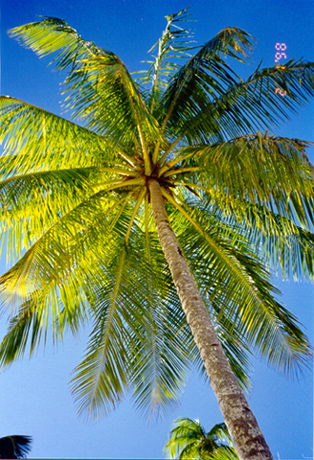Coconut
Botanical Name: Cocos nucifera Sanskrit name: Narikel Hindi Name: Nariyal
The strong winds buffeting the coasts where the graceful coconut palm grows make it impossible to find straight coconut tree, so Indians ensure an additional path to heaven by offering its large, oval nut in their religious rituals. Unripe
coconut fruit is an essential part of all Hindu religious ceremonies. Even in areas where coconut palms do not grow, no puja or offering is complete till a coconut is offered.
 Fishermen offer coconuts to the sea to propitiate Varuna, Lord of Winds and Waters. The coconut is an essential element in wedding ceremonies, often placed in a pitcher of water placed on paddy, a branch of the mango tree is placed in
the pitcher and a coconut adorned with sandal paste, vermilion and flowers is placed on that branch. This is called full pitcher… Purnakumbha, which is symbolically invoked as gods and goddess for the successful end to any mission undertaken.
Fishermen offer coconuts to the sea to propitiate Varuna, Lord of Winds and Waters. The coconut is an essential element in wedding ceremonies, often placed in a pitcher of water placed on paddy, a branch of the mango tree is placed in
the pitcher and a coconut adorned with sandal paste, vermilion and flowers is placed on that branch. This is called full pitcher… Purnakumbha, which is symbolically invoked as gods and goddess for the successful end to any mission undertaken.
The coconut is considered by Indians to be the fruit of aspiration, and a guarantee of auspicious beginnings, a coconut is split at the inauguration of any Indian function, from the launching of a ship to the first take of a movie spectacular,
to invite the blessings of god.
The legend connected with its origin, is that Rishi Vishwamitra practiced severe austerities for a long time and in the end acquired super human powers. To prove his prowess, he decided to send Satyavrata to heaven in his earthly body. Satyavrata
had been exiled from his kingdom by his father, for seducing the wife of a citizen. During the period of exile, there was a severe famine and Satyavrata looked after the wife and children of Vishwamitra while the latter was away. Since Satyavrata desired to
reach heaven in his mortal body, Vishwamitra repayed him for having looked after his family by fulfilling his desire and raised him to heaven in his mortal body inspite of strong opposition from sages and gods. When Satyavrata reached Indra’s heaven in his
mortal body, Indra was furious: “How can a mortal reside in my domain in his earthly body? Only souls are permitted.” Feeling annoyed at the audacity of Rishi Vishwamitra, he hurled Satyavrat’s body out of his domain. When Rishi Vsihwamitra saw this, he was
indignant. His very first was coming to naught. For Satyavrata’s body to come back to earth not only meant insult but also an acceptance of defeat at Indra’s hand. So Vishwamitra used his magical power again and stopped the king from falling to the earth.
This resulted in Saytavrata being suspended in air. To prop him Vishwamitra put a pole under him. In course of time, the pole became the coconut palm which is as straight and unbranched as the pole which rishi Vishwamitra had taken to stop his further fall.
Satyavrata remained suspended in the midair and got the epithet Trishanku, one who is neither here nor there. Coconut fruit has a coarse outer fibre covering which symbolically resemble the hair of the king and two prominent black spots on the outside, his
eyes.
Coconut fruit fulfills one desires and is offered to deities. It is also considered as symbol of Lord Shiva because it has three black spots and Shiva has three eyes. In Gujarat, it is said that the bride offers a coconut to her bridegroom
and he preserves it throughout his life. In Mysore, it is worshipped as a family god.
However, the true sacredness of the coconut comes from the spectrum of food and medicine it offers for the use of mankind. High in proteins, minerals and vitamins, and representing an ecosystem complete in itself, the coconut provides milk,
water, cream, oil and hard flesh to Ayurvedic medicine for a variety of cures, from the treatment of burns and restoration of hair growth, to the dissolving of kidney stones and treatment for the heart and blood pressure.
_______________________________________________________________________
Importance of Indigenous plants in Indian Mythology and folklore—Compiled by Ms. Priti Sawant